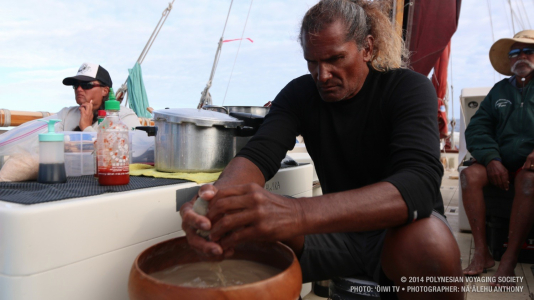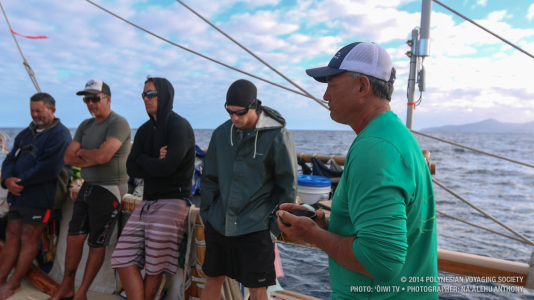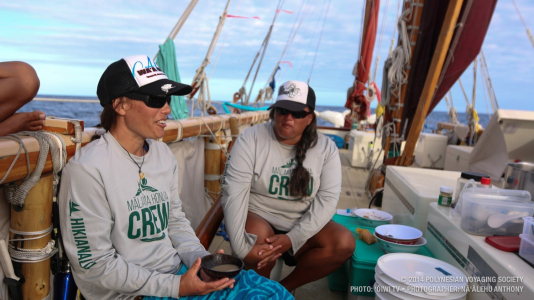Crew Blog | Jacko Thatcher: Rangitahua
- Posted on 9 Nov 2014
- In Crew Blogs
I have a tradition that I follow whenever I voyage to islands I haven’t been to before—I drop a small kohatu (stone) into the waters of those Islands to allow me and mine to connect with these places.
Sunrise on November 2. When a watch change was called, and after a little contemplation, our navigator Kaleo Manuiwa calculated that today we should start looking for the island, Rangitahua. Earlier that morning I pointed out to him that the star Menkalinan was showing through the clouds; with its paired star it looked to be on the meridian, pointing down to true North. Kaleo was hoping to measure the starʻs height above the horizon to estimate our latitude.
Sixteen degrees above the horizon would indicate that we were in the vicinity of Rangitahua; unfortunately, the star disappeared into the clouds before Kaleo could measure its altitude accurately. I had already measured it and believed that it was around 16 degrees, although the accuracy was questionable with the weather conditions making it difficult to see the horizon, especially for my 54-year-old myopic eyes. With his younger vision, Kaleo would probably have gotten a moreaccurate estimate.
Based on my sighting, we were looking for the island. Many cloud formations on the horizon were doing great impressions of land, only to rise into the heavens. One such formation held its form for a long period of time and we came to accept that it was Rangitahua. We carried on sailing, and another island sighting, made by Ka‘iulani Murphy, appeared ahead of us. This sighting looked like three islands, and although this seemed strange, we began to think that we were heading towards McCauley Island, Curtis Island, and close neighbor Cheeseman. As we approached these islands it soon became clear that they were in fact one big Island – that this was actually Rangitahua in front of us. So a poorly measured sighting of a meridian star masked what was a great piece of navigation by our two younger Hoʻokele, Ka‘iulani and Kaleo, as they had unerringly lead us to our destination.
The signs that we were on track were multiple visitations first by what I think were huge Bottlenose Porpoises, then a big pod of Pilot Whales and bigger whale blowholes being seen off or starboard beam and stern, these kaitiaki (guides) following us all the way to the Island.
Captain Bruce Blankenfeld informed us that we would sail close to the island, drop our gear, and have an ‘Ava Ceremony to celebrate our arrival in New Zealand Waters and to remember all those that have been involved with Hōkūleʻa and her missions in the past, those men and women that paved the way for our new mission of Mālama Honua.
Bruce asked that we (the Maori contingent) open the ceremony with our thoughts and feelings for the voyage so far. Frank Kawe spoke first with a mihi to the crew and his observations of what we could expect once we arrive in Aoteraoa. Nick Marr spoke of his connections to his tupuna through whakapapa to his waka Te Arawa. I spoke last and my mihi was in appreciation of the closeness that was developing amongst our crew and how this is what I have always felt when sailing on Hōkūleʻa, even though my last voyage on her was in 1995, not counting the short excursions in the years since. My mihi took in all of the kupuna whose names are engraved on the plaque on the port stern of Hōkūleʻa, Sir James Henare and Tupi Puriri of Te Taitokerau being amongst the legends of Hōkūleʻa, David Lewis whom I sailed with at the end of our epic Na ‘Ohana Holo Moana voyage of 1995, Uncle Pinky Thompson the tiny wee giant of a man who looked after us in his home during that time, and of course, Mau Piailug, who so unselfishly shared with us his knowledge that has led us to where we are today, giving Hōkūleʻa and her crew a second viewing of Rangitahua.
 I spoke to the crew of my aloha for one other whose name appears amongst the legends like Leon Sterling, Mike Tongg and my very dear friend Clayton Bertlemann. Amongst these was a young Hawaiian guy who became a great friend of all of us that refer to those endless summer days training on Hōkū—Kaʻau McKenny the first of the boys of summer. I have a tradition that I follow whenever I voyage to islands I haven’t been to before—I drop a small kohatu (stone) into the waters of those Islands to allow me and mine to connect with these places. The stone I dropped at Rangitahua was a tohu Maumaharatanga ki Kaʻau, a sign of remembrance and love that connects him to his ʻOhana in Aotearoa. I dropped a small piece of Green Stone into the waters, ahakoa iti he iti mapihi pounamu; although small, it is pounamu, and therefore most precious. Summer will never be as bright with out Kaʻau to smile and brighten even the darkest of days. Moe mai e hoa moe mai i to moengaroa.
I spoke to the crew of my aloha for one other whose name appears amongst the legends like Leon Sterling, Mike Tongg and my very dear friend Clayton Bertlemann. Amongst these was a young Hawaiian guy who became a great friend of all of us that refer to those endless summer days training on Hōkū—Kaʻau McKenny the first of the boys of summer. I have a tradition that I follow whenever I voyage to islands I haven’t been to before—I drop a small kohatu (stone) into the waters of those Islands to allow me and mine to connect with these places. The stone I dropped at Rangitahua was a tohu Maumaharatanga ki Kaʻau, a sign of remembrance and love that connects him to his ʻOhana in Aotearoa. I dropped a small piece of Green Stone into the waters, ahakoa iti he iti mapihi pounamu; although small, it is pounamu, and therefore most precious. Summer will never be as bright with out Kaʻau to smile and brighten even the darkest of days. Moe mai e hoa moe mai i to moengaroa.
The last part of my korero was in regards to the special nature of this place where some of our ancestral waka came. Te Kurahaupo ran aground here and Tupuna Waka, Mataatua, Te Arawa, Tainui, and others lent aid to the stricken waka. So Hōkūleʻa in recent times continues the legacy begun centuries before by returning to this place in the same way our ancestors would have.
Each of our crew were then given the time to talk story and express their feelings, enjoying each others company over a cup of ‘Ava before continuing on. My feeling of awe towards my tuakana Bruce for his humility in taking the lead to serve each of his crew members their cup, the respect for our skipper with his unique and engaging manner knows no bounds.
Jacko Thatcher
The Gecko






